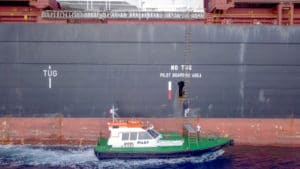
A veteran harbor pilot has suffered a fatal maritime injury while attempting to board a cargo ship. The pilot’s death made headlines in the Northeastern United States due to his more than 35 years of service in New York and New Jersey harbors.
Harbor Pilot Suffers Fatal Maritime Injury
According to the U.S. Coast Guard, the harbor pilot was boarding the container ship Maersk Kensington when the accident happened. At around 4:30 in the morning, the pilot attempted to climb the Jacob’s Ladder from the pilot ship onto the container ship. Both ships were in a channel of water located between Brooklyn and Staten Island.
As the pilot climbed the Jacob’s Ladder, something happened causing him to fall backward onto the deck of the pilot ship. He was taken to the hospital and died a short time later. The U.S. Coast Guard is continuing an investigation into the cause of the fatal maritime injury.
The Sandy Hook Pilots Association – a union of harbor pilots – expresses their sadness over the loss. The veteran harbor pilot had more than 35 years of experience piloting ships in and out of some of the busiest harbors in the U.S.
What is a Harbor Pilot?
A harbor pilot is someone who navigates large ships into harbors or through small bodies of water. Most busy harbors in the U.S. receive cargo and container ships and oil tankers from all over the world. The harbor pilot is the person who helps guide these behemoths of the sea into safe harbor.
The pilot generally has extensive familiarity with the local bodies of water. He or she also must understand the nature of the bodies of water. In places like New York Harbor, large container ships must be carefully guided into the small channels so they do not collide with structures or other ships. The role of a harbor pilot is one of extreme importance.
Harbor pilots receive a great deal of education and training before obtaining licensure by the state. They essentially become experts on the port that they operate out of. Most pilots work out of the same port for their entire career. Pilots must be able to navigate a variety of ships, including tankers, container ships, cruise ships and barges. They must be able to communicate with ship captains that may not speak English.
Maritime Injury Risks for Harbor Pilots
Being a harbor pilot is a lucrative job that demands respect, but it is also a dangerous one. Some people even refer to the position as “treacherous and unpredictable.” Since 2006, four harbor pilots have died while doing their jobs. The most significant risks are:
Boarding the Ship
The most dangerous part of the job is climbing the pilot ladder. Harbor pilots often climb the ladder while the ship is moving and the pilot craft is moving alongside. They must time their movements to avoid missteps. Harbor pilots will jump from the pilot craft to the larger ship and grab hold of the ladder. Then, they climb up to three stories to reach the helm.
Sometimes harbor pilots arrive on cargo ships by helicopter. The helicopter hovers over the ship and lowers the pilot down. This maneuver is dangerous in the best of circumstances, but if there is poor weather or surf conditions, it can be deadly.
Once the pilot is onboard, he or she must then consider numerous factors while guiding the ship into harbor. Pilots must be aware of their surroundings and watch for other ships, obstacles and weather-related dangers.
Drowning
Drowning is one of the primary dangers of working in the maritime industry. Between 2000 and 2014, 210 people died due to falling overboard from a vessel. Drowning is considered the third leading cause of unintentional death worldwide, accounting for seven percent of all deaths.
There are many situations that contribute to drowning in the maritime industry, including:
- Vessel sinking
- Falls overboard
- Falls from a dock
- Failure to use personal flotation devices
- Improper training
- Failure to follow safety guidelines
Being Struck by Another Vessel
Harbor pilots are at risk of being hit by a vessel if they fall into the water or perch on the side of a vessel. Harbors are very busy, and captains and pilots must communicate well in order to avoid collisions or falls overboard. If someone does fall into the water, it is important to act quickly to get him or her out. Large ships and barges may not be able to see in the water ahead of the ship.
Getting Help After a Maritime Injury
Harbor pilots are not the only maritime workers who are at risk for suffering a maritime injury. In fact, maritime workers in most facets of the industry are vulnerable to accidents and injuries related to their work. After an injury, it is important to know that there are maritime laws that protect your legal rights.
Maritime law protects workers and their families and provides benefits for workers who suffer a maritime injury on the job. Where traditional workers’ compensation laws do not provide benefits, maritime injury laws can.
To find out more about maritime laws and your rights, contact Maritime Injury Guide.
Sources:
- https://patch.com/new-jersey/middletown-nj/man-dies-after-fall-container-ship-sandy-hook-bay
- https://www.npr.org/2012/03/21/149091141/harbor-pilots-reap-high-rewards-for-dangerous-job
- https://www.palmbeachpost.com/article/20150422/BUSINESS/812063254
- https://www.who.int/news-room/fact-sheets/detail/drowning